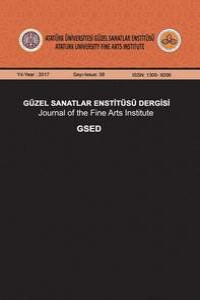Abstract
19. yüzyılın ikinci yarından sonra Paris’te Paul Cézanne, Vincent Van Gogh, Pierre Bonnard ve Edouard Vuillard gibi empresyonistler, Henri Matisse ve André Deraing gibi fauvistler, fikirleriyle ve yaptığı çalışmalarla Avrupa’da Kübizmin’in İtalya’da Fütürizm’in Fransa’da ise Orfizm’in doğmasına zemin hazırlamışlardı. Böylesine hareketli olayların yaşandığı bir sanat ortamından beslenen ve 20. Yüzyıl teknolojik gelişmeleriyle birlikte olağanüstü bir şahlanışla gelişen ve hatta kendinden öncekine başkaldıran çağdaş sanat akımları da en az etkisi klasik sanat akımları kadar güçlü idi.
1960’lı yıllardan sonra tekstil sanatlarının önemli başyapıtlarından sayılan özgün giysi tasarımlarının birçoğu, çağdaş sanat akımlarıyla ilgilenen ve ondan ilham alan giysi tasarımcılarının eserleriyle doludur. Özellikle içinde yaşadığımız yüzyıl boyunca teknik alandaki gelişmeler her disiplin dalında olduğu gibi tekstil sanatçılarının da vazgeçilmezleri arasına girmiş, yarattıkları özgün giysi tasarımlarında gelişen bu yeni teknolojileri serbestçe kullanabilmişlerdir.
Bu çalışmada; çağdaş sanat akımlarında yer alan giyilebilir sanat ve beden sanatı ile ilintili dijital tekstil uygulamaları ele alınmış ve belirlenen başlıklar altında çağdaş sanat akımlarının tarihsel perspektifi içinde yer alan giyilebilir sanat ve beden sanatı, dijital tekstil uygulamaları örnekleri üzerinden incelenmiştir.
Keywords
Çağdaş Sanat Akımları Dijital Tekstil Tasarımı Giyilebilir Sanat (Wearable Art) Beden Sanatı (Body Art)
References
- Ahmetoğlu, Ü., Denli S. (2103). “Soyut Dışavurumculuğun Ortaya Çıkışı ve Türk Resim Sanatına Yansımaları”. İnönü Üniversitesi Sanat ve Tasarım Dergisi, İnönü University Journal of Art and Design ISSN: 1309-9876 E-ISSN: 1309-9884 Cilt/Vol. 3 Sayı/No.8 (2013): 173-188,
- Ayaydın, A. (2015). “Empresyonizm (İzlenimcilik) Akımının Güncel Bakış Açısıyla Bazı Yönlerden İncelenmesi”. 2015, Cilt 3, Sayı 2, Volume 3, Issue 2, DOI: 10,7816/sed-03-02-05
- Biber Vangölü, (2015). “Geçmişten Günümüze Gerçeküstücülük”, Atatürk Üniversitesi Sosyal Bilimler Enstitüsü Dergisi, Eylül2016 20 (3): 871-883
- Dale, J. S. (1986). Art to Wear, England, Abbeville Press
- Demirparlak, S. (2006). “Giyim Modasında Gerçeküstücü Yaklaşımlar”. Dokuz Eylül Üniversitesi GSE, İzmir
- Germaner, S. (1997). 1960 Sonrası Sanat, Kabalcı Yayınevi, İstanbul
- Güvemli, Z. (1968). Başlangıçtan Bugüne Türk ve Dünya Sanat Tarihi, Varlık Yayınları, İstanbul
- Konak, C. (2016). “‘Cezanne' İn İzinden “Kübizm””, Akademik Sosyal Araştırmalar Dergisi, Yıl: 4, Sayı:26,Mart2016,s.294-301, http://www.asosjournal.com/Makaleler/1885960533_1062%20Ceyhun%20KONAK.pdf
- Kodaman, L., Sari, S. (2103). “Disiplinler Arası Bağlamda Tuval Resimlerinin, Dijital Baskı Yöntemi Kullanılarak Giyilebilir Sanatta Uygulanmasına Yönelik Bir Çalışma”, Cumhuriyet International Journal of Education-CIJEe–ISSN: 2147-1606 Vol 2 (4), 2013, pp. 72-83
- Kahraman, H.B. (2005). Sanatsal Gerçeklikler, Olgular ve Öteleri. Agora Kitaplığı / Kültürel Çalışmalar Dizisi, İstanbul
- Lynton, (1993). Modern Sanatın Öyküsü. İstanbul: Remzi Yayınevi
- İpşiroğlu, N., İpşiroğlu, M. (1993). Sanatta Devrim. İstanbul: Remzi Kitabevi.
- Ünsal, G., Sarı, S. (1997). “Paris’te Bir Samuray, ISSEY MIYAKE”. E.Ü. Tekstil ve Konfeksiyon Dergisi, Yıl:7, Sayı:4, İzmir
Abstract
Impressionists such as Paul Cézanne, Vincent Van Gogh, Pierre Bonnard and Edouard Vuillard in Paris, fauvists such as Henri Matisse and André Deraing had their backgrounds and their work done in Europe with Cubizm in Italy and Futurism in France and Orphism in France After the second half of the 19th century. Contemporary art movements that were stronger than such animated events that were fed and technological developments of the 20th century at least as far as classical art movements.
Many of the original garment designs that are considered important masterpieces of textile arts are full of clothes designers who are interested in and inspired by the trends of contemporary art after the 1960s. In particular, developments in the technical field have become indispensable in textile disciplines as well as in disciplines, and they have been able to use them for centuries during which we have freely living these new technologies.
In this study; under the specific headings by taking into account the digital textile applications related to the wearable art and body art. Has also been examined through examples of digital textile applications of the wearable art and body art.
References
- Ahmetoğlu, Ü., Denli S. (2103). “Soyut Dışavurumculuğun Ortaya Çıkışı ve Türk Resim Sanatına Yansımaları”. İnönü Üniversitesi Sanat ve Tasarım Dergisi, İnönü University Journal of Art and Design ISSN: 1309-9876 E-ISSN: 1309-9884 Cilt/Vol. 3 Sayı/No.8 (2013): 173-188,
- Ayaydın, A. (2015). “Empresyonizm (İzlenimcilik) Akımının Güncel Bakış Açısıyla Bazı Yönlerden İncelenmesi”. 2015, Cilt 3, Sayı 2, Volume 3, Issue 2, DOI: 10,7816/sed-03-02-05
- Biber Vangölü, (2015). “Geçmişten Günümüze Gerçeküstücülük”, Atatürk Üniversitesi Sosyal Bilimler Enstitüsü Dergisi, Eylül2016 20 (3): 871-883
- Dale, J. S. (1986). Art to Wear, England, Abbeville Press
- Demirparlak, S. (2006). “Giyim Modasında Gerçeküstücü Yaklaşımlar”. Dokuz Eylül Üniversitesi GSE, İzmir
- Germaner, S. (1997). 1960 Sonrası Sanat, Kabalcı Yayınevi, İstanbul
- Güvemli, Z. (1968). Başlangıçtan Bugüne Türk ve Dünya Sanat Tarihi, Varlık Yayınları, İstanbul
- Konak, C. (2016). “‘Cezanne' İn İzinden “Kübizm””, Akademik Sosyal Araştırmalar Dergisi, Yıl: 4, Sayı:26,Mart2016,s.294-301, http://www.asosjournal.com/Makaleler/1885960533_1062%20Ceyhun%20KONAK.pdf
- Kodaman, L., Sari, S. (2103). “Disiplinler Arası Bağlamda Tuval Resimlerinin, Dijital Baskı Yöntemi Kullanılarak Giyilebilir Sanatta Uygulanmasına Yönelik Bir Çalışma”, Cumhuriyet International Journal of Education-CIJEe–ISSN: 2147-1606 Vol 2 (4), 2013, pp. 72-83
- Kahraman, H.B. (2005). Sanatsal Gerçeklikler, Olgular ve Öteleri. Agora Kitaplığı / Kültürel Çalışmalar Dizisi, İstanbul
- Lynton, (1993). Modern Sanatın Öyküsü. İstanbul: Remzi Yayınevi
- İpşiroğlu, N., İpşiroğlu, M. (1993). Sanatta Devrim. İstanbul: Remzi Kitabevi.
- Ünsal, G., Sarı, S. (1997). “Paris’te Bir Samuray, ISSEY MIYAKE”. E.Ü. Tekstil ve Konfeksiyon Dergisi, Yıl:7, Sayı:4, İzmir
Details
| Journal Section | Articles |
|---|---|
| Authors | |
| Publication Date | May 29, 2017 |
| Submission Date | March 14, 2017 |
| Published in Issue | Year 2017 Issue: 38 |
Obtaining permissions for studies requiring ethics committee approval regarding the implementation of ethical rules and including information about permission in the article was added to the criteria. In this direction, Ethics Committee Permission is required for articles submitted to our journal and meeting the conditions stated below.
• Any research conducted with qualitative or quantitative approaches that require data collection from participants using questionnaires, interviews, focus group work, observation, experimentation, and interview techniques.
Also;
• Obtaining and indicating permission from the owners for the use of scales, surveys and photographs belonging to others,
• It should be stated that the copyright regulations are complied with for the intellectual and artistic works used.


